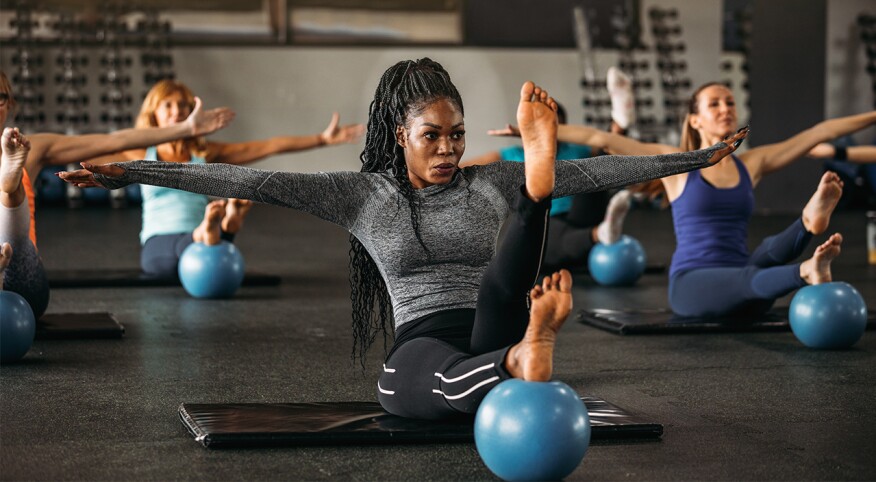I confess that my interest in Pilates was sparked by vanity.
I saw celebrities like Lori Harvey claiming the exercise method was the secret to their six pack and I wanted in on the abs action.
But after my first 50-minute class, I knew that Pilates was about to become not only my favorite form of strength training but also one of my most transformative forms of self-care. While I’m no longer focused on my size or shape, I have noticed after several classes that my clothes fit better, including that jumpsuit in my closet that I used to think I was too fluffy to wear.
I have noticed after several classes that my clothes fit better.
I was reluctant to try a Pilates class at first because I believed everyone at the studio would be skinny, white, 20-somethings. But after a curvy Black woman in my friend group told me she’d been taking classes regularly I decided to give her studio a try.
To my surprise, there’s always been at least one other Black woman in each class I’ve taken so far, and the body sizes and types run the gamut. The age range of my fellow participants is wide too. The studio I frequent also employs two Black instructors.
Pilates’ “hidden figure” infused this fun workout with Black Girl Magic.
“When we don't see us doing something, we say, ‘Oh, that's for white people, that's not for us. So, I'm not going to do it,’” says Sonja Herbert, founder of Black Girl Pilates, an online collective for Black women who teach Pilates. “And then we find out that we have a huge, long history of this amazing thing. We were a part of it.”
A Black woman was key to Pilates being what it is today
If I’d done some research before my first class, I would have known exactly what Herbert means.
Yes, Pilates was created by a European man. Joseph Pilates developed the technique in the 1910s and 20s in part while he served during the First World War as an orderly in a hospital on Isle of Man where he worked with patients unable to walk. He put springs on the hospital beds to help support their limbs. Much of the equipment he used would be adapted into the machines used in Pilates classes today.
But did you know that one of the most revered Pilates instructors was a Black woman?
Kathleen Stanford Grant (1921-2010), was a first-generation Pilates teacher who studied directly under Joseph Pilates and taught the Pilates method for more than 50 years. She also created Before the Hundred, a technique designed to prepare the body for the Pilates exercises. Grant is considered a pioneer and innovator in the Pilates world.
“A Black woman was key to Pilates being what it is today,” Herbert says.
Could Pilates be the secret to tighter abs?
When we think of our core, we tend to only think about it aesthetically, Herbert says. How can I get nice abs? How can I get a flab-free back?
Pilates urges you to focus on your core’s strength and your ability to move your body more efficiently.
“With Pilates, we can tap into this inner strength to just do life, whether it's picking up groceries or running after our kids or just standing strong,” Herbert says.
Pilates involves a lot of core work, which is why it’s often seen as the secret to great abs. But Herbert warns that we must remember that our genes have a lot to do with how sculpted our muscles can get. Two people could both do Pilates five days a week and see vastly different results.
Thanks to Pilates, I’m happier with who I am, but it has nothing to do with how I look.
“I think it's important that we that we concentrate more on feeling strong than looking strong,” Herbert says.
That’s one of the reasons I’m so quick to preach the power of Pilates. My body doesn’t look much different than it did when I started Pilates this summer. But I feel so much stronger. My lower back pain is gone. I sit up straighter. And even my balance has improved.
I’ve never struggled with motivation to do cardiovascular workouts. I love walking and dance aerobics and if I’m feeling froggy I might even go for a run or go to a cycling class. But strength training bores me so I often fail to get in those two days of muscle strengthening activities that the U.S Department of Health and Human Services recommends we do each week. Until Pilates.
Pilates is a strength training activity I actually look forward to doing. I’m eager and determined to fit at least two classes into my schedule each week.
But for me, Pilates is more than a workout. It’s also an escape.
When I’m in class I can’t worry about work deadlines, family drama, or anything else because I’m focused on breathing and following the instructor’s cues. Outside of the Pilates studio I am the person everyone always turns to for help. In Pilates class, I relish getting help from the instructor as she assists me in positioning my body and equipment properly to perform the exercises safely.
Pilates time is my time.
Herbert says Pilates is a form of self-care for her as well and for many of her students too. She recalls one client, who was about 84 years old and did Pilates five days a week. Her husband was in the hospital, and she would visit him daily but still made time for Pilates.
“That was her sanctuary,” Herbert says.
Thanks to Pilates, I’m happier with who I am, but it has nothing to do with how I look.
“It’s the confidence that comes with performing an exercise that has always been an issue and you finally get it,” Herbert says.
I'll be 80 or 90 still doing Pilates. If I can't do anything else, I can always do Pilates and I can do it anywhere.
Join free Pilates classes compliments of AARP—right where you are!
If AARP’s Virtual Community Center is already one of your regular hangouts, you know that Pilates-based training for various ability levels is offered week after week. (It’s always a good idea to check in with your health care provider before starting a new exercise routine.) You don’t need to be an AARP member to register and enjoy these classes. Coming soon:
Tuesday, Nov 21, 2023
Yoga + Pilates for Strength and Balance
This class focuses on enhancing vitality and mental clarity, strength and balance.
Monday, Nov 27, 2023
Mindful Movement for Healthy Aging
Enjoy mindful movements from yoga, Pilates and functional medicine to improve your core strength, ease of movement and balance and help with achy feet, tight hips, low back pain, restrictions in mobility and more. You may also find you’re feeling less stressed and sleeping better!
Monday, Dec 4, 2023
40-Minute Pilates: Grounding and Balance
This is a beginner Pilates class and offers modifications for all fitness levels.
Your instructor will use a tennis ball and chair as props to help you find your optimal movement potential, so you aren't fighting against gravity. By the end of the class, the goal is that you will feel that your body moves more efficiently and freely.
You'll earn 500 points in the AARP Rewards loyalty program by attending this December class; points can be redeemed for discounted gift cards and other deals.
Limber for a lifetime
If you’re interested in continuing your Pilates practice with in-person classes, Herbert suggests trying out a few different studios until you find the right fit.
“Some studios are not for everybody,” she says. “Do you feel like the teacher is paying attention to you as a new student? Are they giving you good cues? Are they telling you exactly what they want you to do? Is their pace something that you can keep up with?”
Herbert, who’s 54, has been teaching Pilates since 2007. She took her first Pilates class in 2006 and she’s confident the technique will always be a part of her life.
“I'll be 80 or 90 still doing Pilates,” Herbert says. “If I can't do anything else, I can always do Pilates and I can do it anywhere.”











